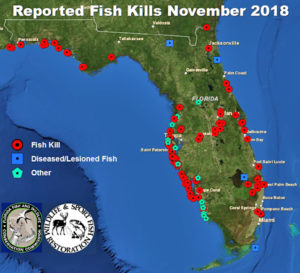Florida feels the lasting effects of algae blooms
In August, the Global Resilience Institute posted an article about the inland and coastal algae blooms affecting Florida. Now, heading into the New Year, the state is finally breathing a sigh of relief with its red tide algae blooms almost entirely gone from the Gulf Coast of Florida. According to the Florida Fish and Wildlife Conservation Commission’s December 10-18 Red tide status map, there is only one isolated location where there is still a high concentration of Karenia brevis, the organism responsible for the red tide algal blooms.
This red tide has been unusually long and severe, persisting for over a year, since October of 2017. Red tide occurs annually in the summer months as the longer days and hotter temperatures promote algal blooms. Although in the short term Hurricane Irma broke up the 2016 bloom, over a year later scientists blame the prolonged nature of the 2017 red tide on the storm for washing more nutrients into the ocean as well as milder winds last winter that failed to push the red tide offshore.
Florida residents hoped that Hurricane Michael would help break up the blooms rather than make them worse, as Hurricane Irma did. In the end, Michael had no effect on the red tide.
This year’s red tide has had lasting effects both on the environment and on humans.
Fisherman, such as those in the stone crab industry, are particularly feeling the effects. Scientists have found that prolonged exposure to red tide increased mortality for adult crabs and killed off crab larvae. The effect on larvae can mean that populations may not rebound for several years. Some fisherman have sold their boats and traps because the catch is no longer enough to sustain their livelihoods.

The blooms have not only killed off crabs. In Lee County alone, 4 million pounds of dead marine life including fish, turtles, dolphins, and manatees washed up on the beaches. The clean up required almost 40,000 labor hours and $2.55 million, depleting the county’s state-granted red tide clean up fund. The county also used part of its tourism tax savings to purchase two surf rakes, large machines that pick out debris from sand, because of mechanical problems caused by the sand being put through incinerators along with the dead sea life. The investment in the rakes and the training to operate them is expected to help in future red tides.
Outgoing Sen. Bill Nelson (D) and recently elected Senator Rick Scott (R) declared a state of emergency back in August so that affected counties could access federal funds for the clean up. Scott has also faced criticism for cutting state funding for red tide research and environmental monitoring and enforcement that some argue might have prevented the red tide from being so severe. As the governor oversees the state’s water management, the red tide became a major point in Florida’s midterm elections. It is yet unclear whether newly elected Governor Ron DeSantis (R) will put more resources toward the red tides, but as warming temperatures and more frequent storms are expected to prolong algae blooms and worsen their effects, local officials are already preparing for the next red tide.
As Lee County assistant manager Dave Harner said, “We’re better prepared because we went through a number of events since [Hurricane] Irma, and that’s … helped us learn how to mobilize.”
Sources and Further Readings
Red Tide Current Status (Dec 10 – 18) – Florida Fish and Wildlife Conservation Commission
Red Tide in Florida and Texas – National Ocean Service
Why won’t red tide go away? After Hurricane Michael, toxic algae has again spread – Miami Herald
Red tide is spreading in Florida. Hurricane Michael didn’t stop it – CNN
‘The Worst I’ve Ever Seen It’: Lean Stone Crab Season Follows Red Tide in Florida – New York Times
How Florida Counties Dealt With the Red Tide’s Stinking Mess – CityLab
How red tide might sway this election among Florida’s governor, Senate candidates – WTSP10 News
